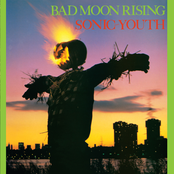Bad Moon Rising

Biography
Bad Moon Rising is the second studio album by the American alternative rock band Sonic Youth, released on the New York independent record label Homestead Records in 1985. The album is loosely themed around the dark side of America, and includes references to obsession and insanity, Charles Manson, heavy metal, Satanism and early European settlers' encounters with Native Americans. Each side of the original vinyl was a mostly continuous cycle of songs, except for the album's closer "Death Valley...
Bad Moon Rising is the second studio album by the American alternative rock band Sonic Youth, released on the New York independent record label Homestead Records in 1985. The album is loosely themed around the dark side of America, and includes references to obsession and insanity, Charles Manson, heavy metal, Satanism and early European settlers' encounters with Native Americans. Each side of the original vinyl was a mostly continuous cycle of songs, except for the album's closer "Death Valley '69". Released to strong reviews from the underground music press, Bad Moon Rising was the first Sonic Youth album to combine the band's experimental material with transitional pieces and segues. Distributed by Blast First in the United Kingdom, it was the band's first release on the distributor. Sonic Youth released one single from the album, "Death Valley '69", which did not chart in either country. Background and production Sonic Youth were an alternative rock band that was formed in New York City in 1981 by guitarists Thurston Moore and Lee Ranaldo and bassist Kim Gordon. The band signed to Glenn Branca's Neutral Records, releasing the Sonic Youth EP in March 1982. As Sonic Youth released a number of albums and EPs to increasing critical acclaim, including Confusion is Sex and Kill Yr Idols in 1983, several drummers joined and left the band. Bob Bert rejoined Sonic Youth after the Confusion is Sex tour in mid-1983. The New York press largely ignored Sonic Youth (as well as the noise rock scene in the city), until after a disastrous London debut in October 1983 that actually received rave reviews in Sounds and NME. When they returned to New York, the queue at CBGB for the band's concerts went around the block. By mid-1984, Sonic Youth were playing almost once a week in the city, but its members started to realise there was little future in their musical approach; Moore later said "it was getting to the point of overkill". They retreated to the rehearsal room, retuned their guitars and changed their equipment so they were unable to play their old songs, and began writing new material. After a period of intense songwriting, the band entered Before Christ Studios in Brooklyn, New York with producer Martin Bisi, who had recorded early rappers and local avantists such as Elliot Sharp, in September 1984 to record their next studio album. Music Bad Moon Rising begins with Intro, a short instrumental featuring several guitars, described by Michael Azerrad as “a melancholic, meowing slide line playing off a delicate stack of crystalline arpeggios”. Intro segues into the next song, Brave Men Run, named after a painting by American artist Edward Ruscha. The song begins with a single riff repeating for a minute, before Gordon murmurs “Brave man run in my family/Brave men run away from me”. The riff fades into the album's third song, Society Is a Hole, “a one-chord hymn to big-city anomie”. Sonic Youth's use of transitional pieces in the album was inspired by their live shows, which featured either Moore or Ranaldo tuning guitars for up to five minutes while the other played slow transitory guitar riffs or prerecorded sound collages. I Love Her All the Time, the album's love song, features extensive prepared guitar by Ranaldo and the use of one chord, with a noise section in the middle; like many of the album's songs, I Love Her All the Time, focuses on texture and rhythm rather than melody. Bad Moon Rising's second side, which comprises the experimental Ghost Bitch (which features Ranaldo on acoustic guitar and references Native Americans' first encounter with European settlers), I'm Insane and Justice is Might expand on the soundscape concept; the songs feature repeating guitar riffs that segue from one song to the next, while Moore and Gordon mumble cryptic lyrics. Death Valley '69, the album's closer, was the result of a collaboration between Thurston Moore and New York singer and poet Lydia Lunch. Read more on Last.fm. User-contributed text is available under the Creative Commons By-SA License; additional terms may apply.
